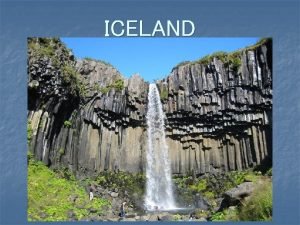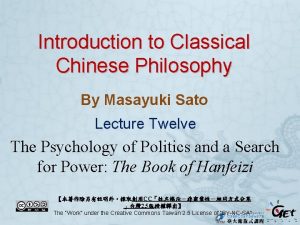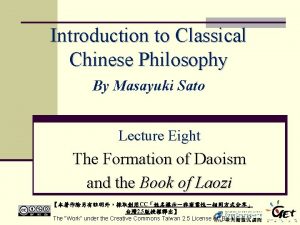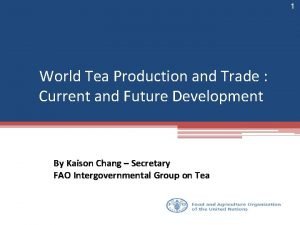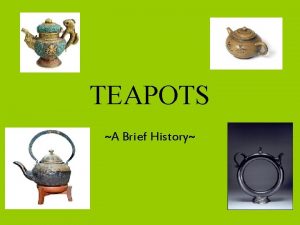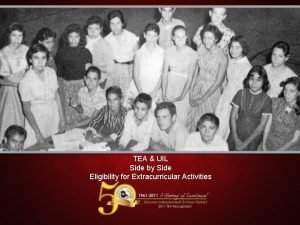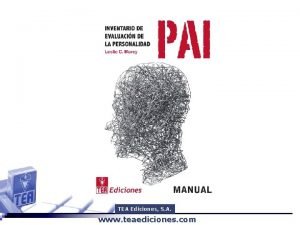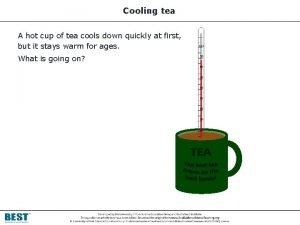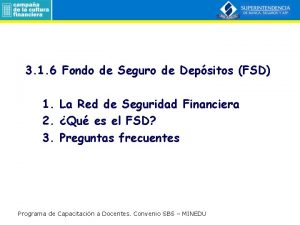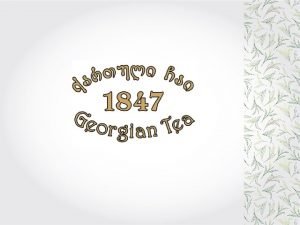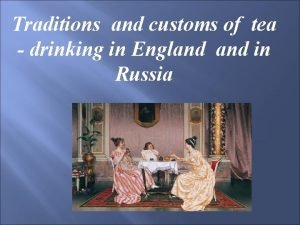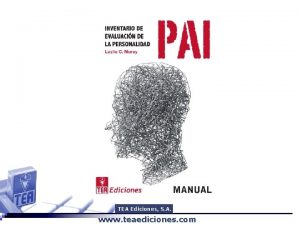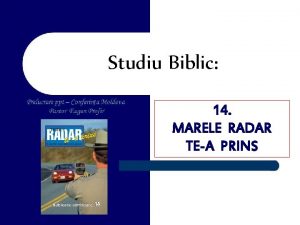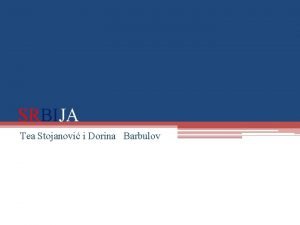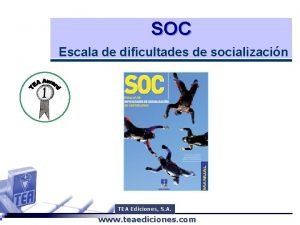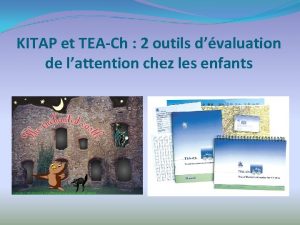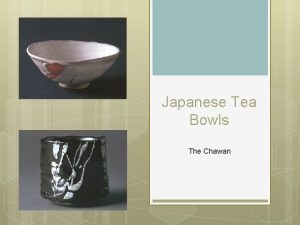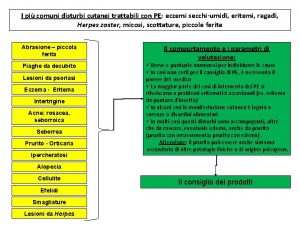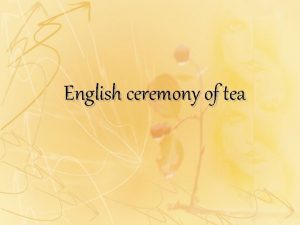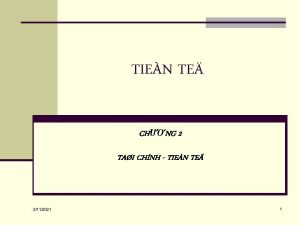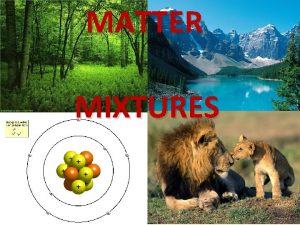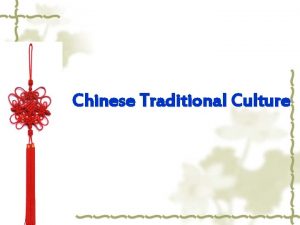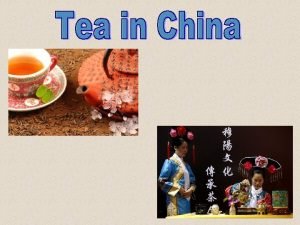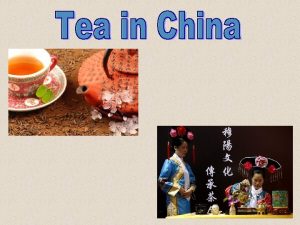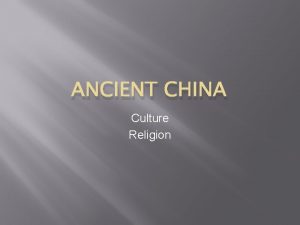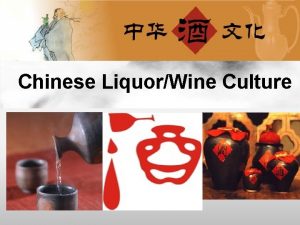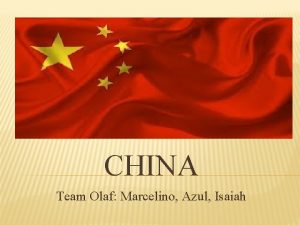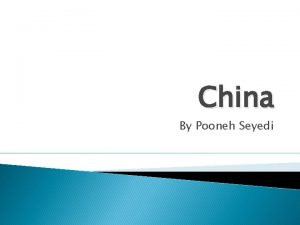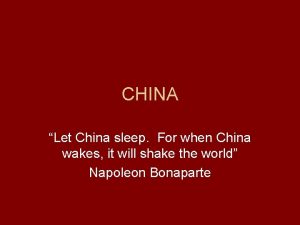Chinese Tea Culture Chinese Tea Culture Introduction China













































































































- Slides: 109

Chinese Tea Culture

Chinese Tea Culture Introduction China, the Hometown of Tea The Importance of Tea in People’s Daily Life Classification of Tea and Health Tea Custom Tea Ceremonies Gongfu Tea and Chinese Culture Tea Service Master Tea utensils

Introduction • Tea (茶) commonly denotes the drink made from steeping(浸泡) the processed leaves, buds(芽), or twigs(枝) of the tea bush (Camellia sinensis 茶树) in water. • Only the top 1 -2 inches of the mature plant are picked. These buds and leaves are called flushes(嫩芽). A plant will grow a new flush every seven to fifteen days during the growing season, and leaves that are slow in development always produce better flavored teas.

• Of the three major beverages of the world-- tea, coffee and cocoa-- tea is consumed by the largest number of people in the world. It has a cooling, slightly bitter, astringent flavor (涩味)which many enjoy.

Introduction Chinese tea culture refers to the methods of preparation of tea, the equipment used to make tea and the occasions in which tea is consumed in China. The terms chayi "Art of Tea 茶艺" and "Tea Ceremony" have been used, but the term "Tea Culture茶文化" includes more than just the ceremony. Also "culture" is easier to translate into English from the Chinese term "art 艺".

Tea culture in China differs from that of Europe, Britain or Japan in such things as preparation methods, tasting methods and the occasions for which it is consumed. Even now, in both casual and formal Chinese occasions, tea is consumed regularly. In addition to being a drink, Chinese tea is used in Traditional Chinese medicine and in Chinese cuisine.

It is universally acknowledged that China is the China, the Hometown of Tea original tea-growing area, as well as the first country to grow, produce and drink tea. The Discovery of Tea The History of tea in China

The Discovery of Tea According to legend, in 2737 BC, Emperor SHEN NUNG a notably skilled ruler, scientist, scholar and patron守护神 of the arts, ruled China’s vast empire. His many farsighted edicts法令 included the requirement that all drinking water be boiled as a hygienic precaution. Shen Nung Tasted Plants

The Discovery of Tea One summer day, while on a state visit to a distant part of his realm, he and the court stopped to rest. Accordingly, servants began boiling water for the royal court to drink. By chance, the wind blew dried leaves from a near by bush, into the boiling water and a brown substance was infused into the liquid. As a gifted herbalist and scientist the Emperor was interested in the newly blended concoction混合物. He examined its properties and after sipping and tasting he declared it to be…”MOST REFRESHING!”

The History of tea in China It has been used as medicine since the primitive society. It has been found in the record documents of China’ Zhou Dynasty about 1100 BC. According to historical data, China began to grow tea about two thousand years ago during the period of the Warring States (475 -221 BC). Drinking tea became a fashion in the Western Jin Dynasty and Tang dynasty. In the Song (960 -1279) and Yuan (1271 -1368) Dynasties tea appraising became a popular custom Since 1700 s, the Chinese tea has largely expended into the world market.

The History of tea in China At present more than forty countries in the world grow tea, with Asian countries producing 90% of the world's total output. All tea trees in other countries have their origin directly or indirectly in China.

Map of Chinese Tea Producing Area 21 Provinces 4 regions


Lu Yu: Sage of Tea “Tea Jing” 茶经(Tea Classics) written by Lu Yu 陆羽 in 760 AD was the first book of tea in the world.

Tea appraising in Ancient China In the Song and Yuan Dynasties a popular custom was. Over the long history of drinking tea, a special and simple Chinese tea culture came into being. Drinking tea was not only for quenching thirst or for enjoyment, but also for the promotion of friendship and mutual understanding. Folk customs of drinking tea reflected the ancient Chinese people's great interest in tea culture. 品茶� 斗茶 Tea Fight

• A tea plant will grow into a tree of up to 16 meters (52 ft) if left undisturbed, but cultivated plants are pruned to waist height for ease of plucking.

Wild Tea Trees in Yunnan Province Height: 32. 12 m


Tea Mountains

The importance of Tea

Tea in Daily Life “Firewood, rice, oil, salt, sauce, vinegar and tea are the seven necessities to begin a day. ” Cu Cha Dan Fann 粗茶淡饭: coarse tea and tasteless dinner

The Importance of Tea in China’s Economy l Tea has always been a vital part of China’s economy. Back in the “Good Old Days” 往昔美好时 光of the Great Wall it was actually used as money! Black Tea was formed into bricks and carried by traders as the caravans 穿越沙漠的)旅行队 ventured west. At that time, a brick of Black Tea was as precious as gold and as important an international currency as the US Dollar is today.

Tea in Literature l 商人重利轻别离,前月浮梁买茶去。 The merchant cared for money more than for me, one month ago he went away to purchase tea. l 酒壮英雄胆,茶引文人思。 Wine can add virginity to heroes while tea can stir up men of letters.

Tea in Art 秉�品茶

Tea Classification l The main varieties of Chinese tea: • • • Green Tea Black Tea Oolong Tea White Tea Yellow Tea Scented Tea

Tea producing technology 制茶 艺


Tea Classification l Other teas: date tea ginseng tea fruit tea eight-treasure tea lotus seed-heart tea Tangerine(柑橘) peel tea Chrysanthemum (菊花)Tea

Green tea 绿茶 l Characteristics • The tea made without being fermented. • The tea liquid and tea leaves are greenish. l Benefits: • It help people reduce their inner heat. • It helps with anti-ageing. • It prevents computer radiation and bad breath.

Green tea 绿茶 l The most well-known green teas: Longjing Tea from West Lake of Hangzhou 西湖龙井 Maofeng Tea from Huangshan Mountain 黄山毛峰 Yunwu Tea from Lushan Mountain 庐山云雾 Biluochun Tea from Jiangsu 洞庭碧螺春

Longjing Tea 龙井 l a top-grade green tea from Longjing, West Lake, Hangzhou l Four characteristics: • green in color 色绿 • fragrant in smell 香郁 • sweet in taste 味醇 • beautiful in appearance形美

Longjing Tea

West Lake

Biluochun Tea 碧螺春 a top-grade green tea from Dongting 洞庭, Taihu, 太湖,Wu County吴县, Jiangsu Province Biluo Peak on Mountain Dongting “Terrifying aroma” 吓煞人香 Emperor Kangxi 康熙 named it biluochun.

Biluochun Tea

Dongting

Black tea 红茶 l Characteristics: • The fermented tea. • The most popular tea in the world. • The tea liquid and tealeaves are reddish. l Benefits: • It facilitates the fostering of yangqi in the human body. • It warms the stomach. • It helps with digestion. • It is a most suitable choice in cold seasons.

Black tea 红茶 l. The most well-known black teas: • Qimen Black Tea 祁门红茶 • Yunan Dianhong Tea 云南滇红 • Sichuan Chuanhong Tea 四川川红

Qimen black tea a top-grade black tea from Qimen 祁门 and Guichi 贵溪 of Anhui Province. In 1915, Qimen black tea was awarded the Gold Medal at Panama International Fair. From then on, it has been popular with people in foreign countries, especially the upper-class people in Britain.

Qimen black tea

Qimen

Oolong tea 乌龙茶 Characteristics: l blue tea 青茶 l The half-fermented tea l an important part of Gongfu tea l The tea leaves are green in the center and red at the edge. Benefits: l It decomposes fat and helps people lose weight.

Oolong tea 乌龙茶 l. The most well-known blue teas: Tieguanyin (Iron Goddess Guanyin) 铁观音 Wuyiyan Tea 武夷岩茶 Taiwan Oolong Tea 台湾乌龙

Tieguanyin 铁观音 Tieguanyin Tea, translated into English as Iron Goddess Tea, is one of the most famous types of Chinese Tea. It has many different translations and is often called Tieguanyin, Ti Kuan Yin, Tikuanyin, Iron Buddha, Iron Goddess Tea, and Iron Goddess of Mercy Tea. Tieguanyin is produced originally in Anxi County(安溪 ) in Fujian Province Tealeaves: dark green in color, similar to that of iron It is said that Tieguanyin has such a strong aroma that even after adding water to the teapot seven times, one can still enjoy the pleasant taste and fragrance. Several legends of Tieguanyin.

Tieguanyin 铁观音

A Legend of Tieguanyin 2 -1 During the reign of Emperor Qianlong there in Fujian Province's Anxi County there was a dilapidated temple that was dedicated to the Buddhist Bodhisattva Guanyin, the Goddess of Mercy. A poor farmer named Wei Yin(魏饮) , on his way to his fields’ everyday, would pass the temple and noticed its deteriorating state. He felt something needed to be done. The farmer was quite poor and didn't have the means to restore the temple, so instead he brought a broom and incense to the temple. He thoroughly cleaned the temple and burned the incense in offering to Guanyin. He did this twice a month for many months.

A Legend of Tieguanyin 2 -2 One night in a dream, the Bodhisattva Guanyin appeared to him and told him of a cave located behind the temple. Guanyin told him that a treasure was waiting in the cave for him. He was told to take this treasure and share it with others. When he woke up, Old Wei headed straight to the temple and found the cave which he had never noticed before. Growing in the cave was a single tea shoot. He took the shoot home, planted it, and nurtured it until it grew into a large bush. The tea he made from this bush was fantastic and unlike any tea he had ever tasted. He knew that this tree was indeed a treasure. He gave cuttings of the bush to all of his neighbors and began selling the plant as Tieguanyin, or Iron Goddess of Mercy. The tree of legend still exists and is considered a national treasure. Located near the tree, carved into the cliff is the name of the farmer who, according to legend, found the original tree.

Anxi 安溪

White tea 白茶 l Characteristics: uncured, non-fermented, non-rubbed, fast-dried green tea • The tealeaves are silver in color and have fine white hair on them. The tea liquid is yellowish in color and sweet in taste, with natural fragrance. l Benefits: It helps dispel heat within the human body. It also enhances immune function It protects the heart and blood vessels.

White tea 白茶 l It is mainly produced in Fuding 福鼎,Zhenghe 政和, and Songxi松溪 of Fujian Province. l. The most well-known White tea: • “yinzhen baihao” 银针白毫 (silver needle with fine hair on them) • “baimudan” 白牡丹 (White Peony )

yinzhen baihao 银针白毫

Yellow Tea 黄茶 l. Characteristics: The tea is produced by letting damp tea leaves naturally turn yellow It has an original smell like that of black tea if the tea is cured with other herbs, but its taste is most similar to green and white teas. l Benefits: It refreshes the mind. It helps clear away heat and toxic materials within the human body.

Yellow Tea 黄茶 l The best well-known: Junshan Yinzhen (君山银针) from Hunan Huoshan Huangya (癨山黄芽) from Mt. Huo, Anhui Meng Ding Huangya (蒙顶黄芽) from Mt. Meng, Sichuan Da Ye Qing (大叶青)from Guangdong

Junshan Yinzhen 君山银针

Scented tea 花茶 l The tea made by mixing and aromatizing tea leaves with scented flowers l It is produced mainly in Fujian, Zhejiang, Jiangsu and Anhui provinces.

Scented tea 花茶 l The most well-known: jasmine tea 茉莉花茶 magnolia tea 玉兰花茶 lotus flower tea 荷花茶 chrysanthemum tea 菊花茶 rose tea 玫瑰花茶

Jasmine tea 茉莉花茶 the most popular among scented tea made from jasmine flowers. The most well-known jasmine flower tea is produced in Fujian Province.

The Steps of Making Jasmine Tea Pick a lot of jasmine flower buds and put them in a clean place; At midnight when the flowers have the strongest fragrance, add green tea to them for absorption; Get rid of the withered jasmine flowers and get the tealeaves baked; Put the baked tealeaves into newly picked jasmine flowers again. This is repeated several times before the tealeaves are ready to be used.

Compressed tea 压制茶 l The tea compressed and hardened into a certain shape • brick tea 砖茶: in the form of bricks • Tuocha 沱茶: in the form of cakes and bowls l good for transport and storage l mainly supplied to the ethnic minorities living in the border areas of the country l mainly produced in Hubei, Hunan, Sichuan and Yunnan provinces

Compressed tea l Brick tea: 砖茶 huazhuan 花砖茶 (flower brick) heizhuan 黑砖茶 (black brick) mizhuan 米砖茶 (rice brick) qingzhuan 青砖茶 (green brick) l Tuocha 沱茶 Xiaguan tuocha 下关沱茶 Pu’er tuocha 普洱沱茶 Sichuan tuocha 四川沱茶

Huazhuan & Heizhuan

Qingzhuan & Mizhuan

Tuocha

Tea Custom Popularity Tea health benefits Social functions Some common practices Tea Ceremony

Tea customs l Popularity: Scented tea is popular in northern China; Green tea is preferred in eastern China; Black tea is optimum for people in Fujian and Guangdong; Compressed tea is mainly for minorities.

Tea and Health l Tea is a natural and healthy drink. Tea contains a lot of nutrients that help to build up good health. Tea is refreshing and helps you work efficiently. Tea is a thirst quencher and aids digestion of food. Tea helps to disinfect and alleviate inflammation. Tea helps urinary output and purge toxins. Tea helps fitness and against cardiovascular diseases.

Social Functions l As a sign of respect: The younger generation shows its respect to the older generation by offering a cup of tea. l To apologize: People make serious apologies to others by pouring them tea. (a sign of regret and submission) l To express thanks to your elders on your wedding day: Traditionally, both the bride and groom kneel in front of their parents and serve them tea.

Tea Served at Wedding Ceremony

Some common practices One should neither pour tea water till the teacup is full nor empty the teapot or teacups while drinking tea. (Shandong Province) If a guest emptied his/her teacup, the host would think he/she does not want any more tea and therefore wouldn’t offer him/her any more tea. Knocking bent index, middle and ring fingers on the table three times to express gratitude to the person who serves the tea.

Tea Ceremony

Tea Ceremonies The Chinese tea ceremony, also called the Chinese Way of Tea, is a Chinese cultural activity involving the ceremonial preparation and presentation of tea leaf. The manner in which it is performed, or the art of its performance is shown in the tea ceremony. Taoism has also been an influence in the development of the tea ceremony. The elements of the Chinese tea ceremony is the harmony of nature and enjoying tea in an informal and formal setting. Tea ceremonies are now being revived in China's new fast-paced culture, and continuing in the long tradition of intangible Chinese art.

Tea Ceremony

Steps to Make Tea Heat the pot: Heat the teapot with boiled water to eliminate peculiar smell. Heated pot can help to release the tea scent.

Steps to Make Tea Place the tea: The mouth of the teapot is usually small, so one should first put the tea in a special halfball vessel and hand it to guests for them to appraise the shape of the tea leaf. Then, put the tea into the pot with a teaspoon. The amount of the tea is about 1/3 of the teapot.

Steps to Make Tea Warm with that pot. the cup: the cups boiled water heats the

Steps to Make Tea High pour: One needs to lift up the kettle high to make a good tea. The tealeaves turn over and scatter in the pot after water pouring in from a high level. This is known as high pour, a better way to get out the aroma of the tealeaves.

Steps to Make Tea Low pour: After the tea is ready, one can pour it into a handless cup. This time, one should keep the pot's mouth as low as possible and close to the cup to minimize escaping of the aroma. This is known as low pour. Normally, pour the first-round brewing and the second-round brewing into one cup, one will have a better taste tea. Repeat this when one makes the third and fourth brewing, and the following rounds as well.

Steps to Make Tea Distribute the tea: Tea is distributed into cups from the handless cup, with an amount of about 7/10 of the cup. Offer the tea: Offer the tea to guests in teacups together with cup pad. Smell the tea: Before tasting the tea, one should first look at its color and smell its aroma. Taste the tea: The Chinese character 品 (taste) is three 口 (mouth) that are put together, which means one should taste one cup of tea in three sips. Before sipping and tasting the tea, one should smile at the tea brewer for one or two seconds to express appreciation.

Gongfu tea

Gongfu Tea Introduction The vessels for Gongfu tea Drinking Process

Gongfu Tea: Introduction What does Gonggu( 功夫) mean in Chinese? l It came into being in the Qing Dynasty. l Gongfu: time-consuming. • choose the appropriate tea set • take time to prepare the tea • take time to taste and drink the tea

Gongfu Tea: Four treasures Kettle: yushu wei 玉书煨 Oven: chaoshan lu 潮汕炉 Teapot: mengchen gua 孟臣罐 Cups: Ruochen ou 若琛瓯 l The tea vessels are small and exquisite.

Gongfu Tea: Drinking Process The teapot and teacups are heated with hot water. Tealeaves are put into the teapot (7/10 of the capacity). Boiling water is poured into the teapot. When pouring boiling water from the kettle into the teapot, one should raise the kettle high. When pouring tea from the teapot into the teacups, one should lower the teapot and keep its spout close to the teacups.

Gongfu Tea: Drinking Process One should not fill one teacup after another, instead, one should put the teacups in a circle and pour a little tea into the teacups each time. Only after two or three rounds of pouring should the teacups be filled with tea. (This is to ensure that each teacup gets an even share of tea and each cup of tea has the same taste. ) Even when only a few drops of tea water is left, the person serving tea should not stop serving; he/her should drip the tea water into all the teacups in turn to the last drop.

Gongfu tea: Drinking Process The person serving the tea should take the teapot handle with his/her thumb and middle finger, push the teapot lid open with his/her forefinger, and make the tea water drip up by means of air pressure. When drinking tea, one should not drink it up all at once; he/she should first smell it, taste it, then drink it slowly. One should strictly follow the rules, otherwise he/she would be considered as ignorant of tea etiquette.

Tea and Chinese Culture In the Tang Dynasty, the word cha (tea) was a complimentary name for girls. Little girls were called “little cha” or “chacha”. 牙牙娇语总堪夸,学念新诗似小茶。--元好问 进得女真千户妹,十三娇小唤茶茶。--朱有燉

Tea and Chinese Culture l Betrothal gifts(订婚礼): tea gifts bridegroom’s family: tea gift giving 下茶 bride’s family: tea gift accepting 受茶 Tea can only propagate(繁殖) by seeds and tea trees cannot be transplanted once they are planted.

Tea and Chinese Culture “Listen to her!” cried Tai-yu. “Just took a little tea from her and she starts to order you about. ” His-feng chuckled. “Only asked a favor, you make such a fuss! And over drinking tea! Now since you have drunk our tea, a daughter-in-law you should be!” On hearing this, the whole party burst out laughing. Tai-yu blushed and turned her head away, saying nothing.



Tea Service Master 茶博士


Tea Service Master 茶博士


Tea Service Master 茶博士

Tea utensils

Tea Sets Fictile(陶) Tea Sets Porcelain(瓷)Tea Sets Ø White-porcelain tea sets Ø Celadon (青瓷 )tea sets Ø Black-porcelain tea sets Lacquer Tea Sets (漆器茶具 ) Glass Tea Sets Metal Tea Sets Bamboo and Wooden Tea Sets

Fictile Tea Sets The purple clay teapot is made of unglazed clay (素烧的, 没有上釉的黏土), which is baked with purple and red mud specially found in the local area. Among the fictile tea sets, the purple clay tea set made in Yixing is regarded as the best one.

Porcelain Tea Sets White-porcelain tea sets: the most famous whiteporcelain producing area is Jingdezhen, and other areas include Liling of Hunan Province, Tangshan of Hebei Province and Qimen of Anhui Province.

Lacquer Tea Sets Lacquer tea sets were put into use in the Qing Dynasty and mainly made in Fuzhou area of Fujian Province.

Glass Tea Sets Glass, transparent and with dazzling luster, is a plastic material used widely. Using glass cup to make tea, one can enjoy a good view of the bright color of the water and the tender tealeaves that are pushed up and down when water is poured in and then slowly stretch.

Metal Tea Sets Metal has great advantage over other materials in tea storage, and tin is the best one compared to all other metals such as gold, silver and copper. Tin pot is mostly made with small mouth and long neck together with a tube-shaped body. Such kind of airproof tin pot can guard tea against moisture, oxidation, light and peculiar smell.

Bamboo and Wooden Tea Sets Bamboo and Wooden Tea Sets: In past days, large rural areas, including tea-producing areas, used bamboo or wooden tea sets to make tea because they were cheap but with good quality. But such tea sets are seldom used nowadays, except some bamboo and wooden pots that are used to store tea, especially teapots made of boxwood(黄杨木) and reedbamboo.

Tea utensils

Tea utensils

Tea utensils

Tea utensils

Tea utensils

Homework for the next unit Introduce local operas in your hometown or opera you like.
 Introduction to tea
Introduction to tea How did the ming dynasty restore chinese rule to china?
How did the ming dynasty restore chinese rule to china? 969
969 Fault line iceland
Fault line iceland Paraguay: packing -news -china -chinese -alibaba -amazon
Paraguay: packing -news -china -chinese -alibaba -amazon Grain cleaning plant
Grain cleaning plant Anglo chinese school
Anglo chinese school Language in life
Language in life Spicet chart
Spicet chart Mohist mechanism
Mohist mechanism Introduction to classical chinese philosophy
Introduction to classical chinese philosophy Introduction to classical chinese philosophy
Introduction to classical chinese philosophy Culture includes
Culture includes Sociologists define a symbol as
Sociologists define a symbol as Batch culture vs continuous culture
Batch culture vs continuous culture Fed-batch
Fed-batch Characteristics of collectivism
Characteristics of collectivism American vs indian culture
American vs indian culture Stab culture and stroke culture
Stab culture and stroke culture Folk culture and popular culture venn diagram
Folk culture and popular culture venn diagram Counterculture vs subculture
Counterculture vs subculture How does popular culture diffuse
How does popular culture diffuse Site:slidetodoc.com
Site:slidetodoc.com Folk culture and popular culture venn diagram
Folk culture and popular culture venn diagram Adaptive culture from inert culture
Adaptive culture from inert culture Pour plate method
Pour plate method Lawn culture method
Lawn culture method Quality culture vs traditional culture
Quality culture vs traditional culture Surface culture deep culture and esol
Surface culture deep culture and esol Pearl culture definition
Pearl culture definition Essay structure introduction
Essay structure introduction World tea consumption
World tea consumption Tea act propaganda poster
Tea act propaganda poster Istarski bucolaj
Istarski bucolaj Their eyes were watching god chapter 12
Their eyes were watching god chapter 12 Chapter 13 tewwg
Chapter 13 tewwg American revolution diorama
American revolution diorama Oral administration staar 2020
Oral administration staar 2020 Tea test aviation
Tea test aviation Telpas alt manual 2022
Telpas alt manual 2022 Tegreen 97 benefits
Tegreen 97 benefits Teapots history
Teapots history Tea griddable
Tea griddable Uil tea side by side
Uil tea side by side Functional tea market share
Functional tea market share Tea ediciones
Tea ediciones Tea curriculum framework
Tea curriculum framework Genus of tea
Genus of tea Tea blank graphic organizers
Tea blank graphic organizers Blank graphic organizers for staar
Blank graphic organizers for staar Tea supplemental aids examples
Tea supplemental aids examples Tea discipline chart
Tea discipline chart Dccr tea
Dccr tea Staar alt 2 released test
Staar alt 2 released test Ace method for saq
Ace method for saq How to write an saq ap world
How to write an saq ap world Tea saq method
Tea saq method How to read pseudocode
How to read pseudocode Trifoliate deformity duodenal ulcer
Trifoliate deformity duodenal ulcer Tea paragraph example
Tea paragraph example Thomas sullivan tea bag
Thomas sullivan tea bag Sodium deficit
Sodium deficit Haldin product
Haldin product Cory green tea
Cory green tea Diagram of sugar dissolving in water
Diagram of sugar dissolving in water Lipton target market
Lipton target market Cooling tea in english
Cooling tea in english Definition of combinatorial chemistry
Definition of combinatorial chemistry Tea student assessment
Tea student assessment Diorama boston tea party
Diorama boston tea party Section break slide
Section break slide Tea y tcea
Tea y tcea Georgia tea plantation
Georgia tea plantation Tea telpas writing samples
Tea telpas writing samples Tea paragraph format
Tea paragraph format Tea tikkanen
Tea tikkanen Causas del autismo
Causas del autismo Tea drinking in england
Tea drinking in england To kill a mockingbird chapter 21 summary
To kill a mockingbird chapter 21 summary Tea dccr manual
Tea dccr manual Texas.assessment.gov
Texas.assessment.gov Tea causas
Tea causas Tea calculation aids 2021
Tea calculation aids 2021 Pai tea ediciones
Pai tea ediciones Tea prins
Tea prins Tea chapter 37 discipline
Tea chapter 37 discipline Chapter 37 discipline chart
Chapter 37 discipline chart Tea stojanovic
Tea stojanovic Sweet tea solute and solvent
Sweet tea solute and solvent Escala soc
Escala soc Bob always drink tea in the morning
Bob always drink tea in the morning Pseudocode for making a cup of tea
Pseudocode for making a cup of tea What is history short answer
What is history short answer Your father / pay the bill?
Your father / pay the bill? Teach 2
Teach 2 Japanese tea bowl shapes
Japanese tea bowl shapes Value addition of tea
Value addition of tea Psoriasi acuta
Psoriasi acuta Tea ceremony in england
Tea ceremony in england Tea teal login
Tea teal login Boston tea party diorama
Boston tea party diorama Soffbord teä
Soffbord teä Tea quality improvement
Tea quality improvement Boston tea party acrostic poem
Boston tea party acrostic poem Tea format saq
Tea format saq Tea bačelić
Tea bačelić Have u ever seen a penguin come to tea
Have u ever seen a penguin come to tea Homogeneous vinegar
Homogeneous vinegar Boston tea party treccani
Boston tea party treccani S or es present simple
S or es present simple



